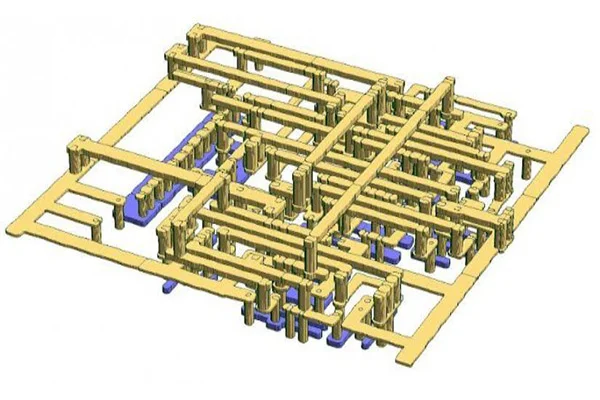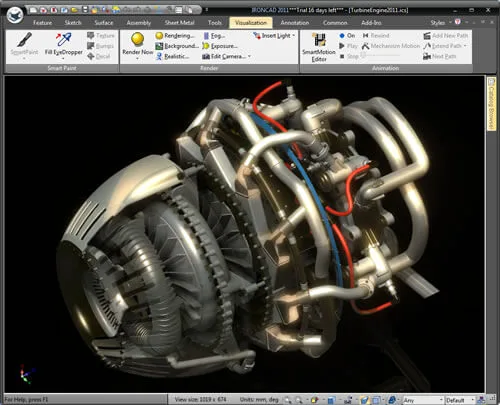Neutral 3D CAD File Formats
- Home
- Blog Details

- November 8 2019
- admin
Various CAD file formats have been developed in recent years. If you’re seeking the most suitable 3D model file, you need to know about the different file formats available. There are many benefits and drawbacks to each format, and you should know which one is right for your needs.
Upon completion, every CAD design/model is saved in a respective file format. A 3D file format stores information about 3D models in plain text or binary data. The 3D formats encode a model’s following characteristics:
- Geometry, which describes its shape
- Scene, which includes the position of light and peripheral objects
- Appearance, which means colors, and textures
- Animations, which define how a 3D model moves
However, not every 3D CAD format stores each of the data mentioned above. Each software comes with its specific 3D file formats. The variety in CAD file formats pertains to many reasons such as cost, feature, etc. It is necessary for any two software to enable interchangeability/interoperability to make things work. Before we talk about that, let’s take a quick walk through the evolution of CAD file formats.

Features of 3D CAD file formats
Everything comes with its variety, and CAD modeling is no stranger. As the technology evolved, CAD modeling came up in different styles and formats. Three-dimensional model files are often stored in one of two formats: Native (.dwg) or Neutral (.dxf). Native files contain the most detail, while Neutral files skip elements and contain only a basic representation. While there are many CAD Neutral file formats, not all of them are created equal. Some file formats have exceptional capabilities or features, while others are less compatible. Some formats are standardized, while others are proprietary.
Considering there are different file types, they will come with specific properties. Other file types allow CAD model viewing in different ways. Some CAD files are limited to only 2D viewing to show the end customer. But since we are talking about 3D CAD models, the following are the main features of 3D CAD file formats:
Native or Neutral
The two main types of file formats are – Native and Neutral.
Native 3D CAD file formats:
All CAD design software uses a proprietary file type. Native formats are those that are native to a specific CAD system. Generally, such file types can only be viewed using the same software it was created with. However, it won’t open in a completely different design program. Proprietary files could be used in intercompany tasks. By using native file formats, designers can ensure that their chosen components are compatible with their PLM software. Native files contain the most detailed representation of 3D CAD models. Some notable native 3D CAD file formats are AutoCAD, Parasolid, Inventor, NX, CATIA, Solidworks, etc.
Neutral 3D CAD file formats:
Neutral 3D CAD file formats are those that are not proprietary to a specific program or file format. These file formats are useful in transferring 3D data from one program to another but do not contain as much fine detail as native CAD files. Neutral files skip elements and include only a basic representation. Neutral CAD file formats ignore the elements that are unnecessary for the software to create the design. Since they are interoperable, they can be viewed on many programs. They are helpful for engineers and designers who need to communicate with other departments and share a single design. Moreover, Neutral formats are not as compatible with all 3D CAD software, and many users do not have the time or budget to learn each one. Neutral data come in handy if the document is distributed to end-users who don’t use CAD software.
Precise or tessellated
CAD designs are displayed in two ways, namely, precise or tessellated. The difference lies in the fact that the product viewed while designing looks quite different from the actual product in real life. It is particularly noticeable in the case of lines and edges that form the product shape. This differentiates between precise drawings versus tessellated drawings.
CAD software uses precise lines and angles to complete complex manufacturing processes to create a product. Such specific instructions must be included in a file format to edit the actual drawing or change its design. The lines and edges are tessellated while displaying a CAD drawing for visual purposes.
Type of assembly
Multi-part designs present a complicated situation when choosing a file format. Depending on the type of file format, multi-part product design may be limited to one single file for the whole assembly. Alternatively, designers also opt for separate files for each component. Awareness of how a particular software will display a multi-part product or if it will display a multi-part product is essential.
Parts Listings
CAD designs generally come with a list of parts. Different formats have different ways of presenting this part list. Some file formats have a Bill of Materials (BOM), while others, called Flat Lists, show all parts one by one. A bill of material showcases a single part and all its positions in a drawing. The latter is better for presenting all parts of an assembly.
Different 3D CAD File Formats
If you plan on using the same tool for several different projects, make sure the CAD tool you’re using is compatible with the standardized formats. Otherwise, you could run into problems. Popular CAD file formats include DXF, DWF, STEP, and Solidworks. Neutral file formats are widely used nowadays as intermediate formats for converting between two proprietary formats to counter interoperability. Naturally, these two known examples of Neutral formats are STL (with a .STL extension) and COLLADA (with a .DAE extension). They are used to share models across CAD software.
Neutral 3D CAD File Formats
STL:
STL, which stands for stereolithography, is the universal format for pure 3D information. It is used in 3D printers and is somewhat loved by CAM. STL denotes only the surface geometry of a 3D object without any representation of color, texture, or other common CAD model attributes. It is a common 3D printer file format. To optimize the file for 3D printing, you can use export settings and the Polygon Reduction tool. A stereolithography file format created by 3D Systems stores the surface shape and geometry information as rough triangles. These files are helpful for CNC prototyping and 3D printing.
AMF:
AMF stands for Additive Manufacturing and is most commonly used in 3D printing. This file format allows the CAD program to chart out any three-dimensional object in a 3D printer based on XML. It is a computer-operated and controlled system that creates three-dimensional objects by carefully sequentially depositing various material compositions in layers. A comprehensive digital layout is fed as design data, and the machine operates accordingly.
STEP:
STEP is the most recommended and widely used 3D file Format. It is an ISO 10303-21 certified standard. Most of the software support STEP importing and exporting. STEP files offer the best interoperability and precision in 3D modeling compared to other file formats. Its NURBS and mathematical functions are used to store data. If you want to exchange 3D models with your partners, you need STEP file format.
IGES:
IGES is the abbreviation for Initial Graphics Exchange Specification. It is a vendor-neutral file format. Using IGES, a CAD user can exchange 3D models in circuit diagrams, wireframes, or solid models. Applications backed by IGES include traditional engineering drawings, analysis models, and other manufacturing functions. The IGES file format was initially limited to basic drawing entities but later added support for B-rep and CSG. IGES was a good choice for exporting 2D CAD drawings and 3D surface models as a neutral CAD format. Solid models, however, have some limitations and need to be closed or exported before they can be imported. STEP files also contain geometric data and are useful for PDM. However, not many CAD vendors support the IGES format.
VRML:
VRML stands for Virtual Reality Modeling Language. It is a standard file format for representing 3D interactive vector graphics.
X3D:
X3D is an ISO standard XML-based file format representing 3D computer graphics. X3D features extensions to VRML (e.g., CAD, Geospatial, NURBS, etc.).
DXF:
DXF stands for Drawing Interchange Format or Drawing Exchange Format. It is a simple 2D format and technically should be viewed as a Native format. It is Autocad’s native 2D format.
The first thing to consider is the file format when it comes to the benefits of Neutral 3D CAD file formats. While every CAD software supports the standard XML format, it still has limitations. Some are proprietary and only work well with a particular CAD program. Others are not standardized and retain their proprietary nature. The primary benefit of using Neutral 3D CAD file formats is that they are easy to transfer. They are free, which makes them a popular choice. Although they may degrade data quality, Neutral file formats help ensure that data from different programs are interchangeable. That way, they are helpful for the designers too. A Neutral 3D CAD file format is an excellent choice for transferring data between CAD programs and a good choice for working with customers and suppliers.
Are you in need of CAD expertise?
Prescient Technology’s impeccable experience in CAD domain has helped lots of companies in addressing their computer-aided design requirements. Have a look at our expertise or get in touch with us today.

